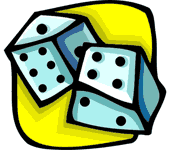EMPIRE BUILDER
Ranking: Four stars
Review
Lots of optimizing and thinking in this game. Overall, we enjoy the game, but sometimes it gets a bit boring because you have to wait for other players to decide what to do once they've drawn a new card after they've delivered a load. You can get stuck with crappy cards and have to decide whether to throw them all away and trust to luck--and then everyone else has to wait a really long time while you consider all nine possibilities on the three new cards. The game rules allow you to ride on other people's rails if you pay, but we never ride on each others' rails, because we don't want to enrich other players. The yellow crayon is invisible. The black crayon covers up the dots. All the crayons will melt if you forget and leave the game in your car during the summer. Some of the games come in a box with a thick map whose sections lock together like big puzzle pieces and with a tray for storing each kind of load separate from all the other kinds of loads; some of the games come in a tube with a plastic map that curls up and no tray to store the loads; some of the games come in either a box or a tube. If you don't have the boxed version with a tray, keeping the various loads in order can be a challenge; we purchased plastic boxes with tiny compartments to store the different loads separately.
Rather than give each of the different Empire Builder game its own separate page, we'll list them all here in descending order of how often we play them, with our thoughts on each. Except for Iron Dragon, they are all essentially the same game played on different maps.
Our Favorites
Empire Builder
This is one of our favorites simply because it's the original game, and because we're fans of the old United States railway system. There aren't any ferries or many rivers to wash out--just lots of land, which we like.
Australian Rails
This is the one we play the most after Empire Builder. There's something about the shape of the map that appeals to us: lots of routes to build north and south on the eastern side of Australia, and it's fun to zoom along routes east and west.
Eurorails
We like the map in this one, too. There's lots of places to go in all directions, and there are ferries--but you can avoid the ferries if you don't like using them.
Russian Rails
Here's another large map with open spaces between many of the cities, somewhat like the layout in Australian Rails. The key to winning seems to be building across the width of Russia, rather than north and south. And it's interesting that the game changes slightly when communism falls (according to a randomly drawn event card).
Ones We Like But Don't Play as Often
Nippon Rails
There are two reasons we don't play this as much as the four games above: the map makes most routes go east-west, so it feels like there's less variety and space to build, and the city names sometimes confuse us.
British Rails
The map seems sort of small somehow, and mostly north-south. OK, we can't really justify it, but we just like the other maps better. Give us land, lots of land . . .
India Rails
Again, the map seems smaller than our favorites. And, again, we can't justify our reaction.
Ones We Almost Never Play
Lunar Rails
We think it's cool to imagine rails on the moon, and we like the notion that you're building on a round surface, so that rails wrap off the side of the map back onto the other side of the map. But in practice, the wrapping around makes our brains hurt.
Martian Rails
We are big proponents of space exploration, but our feelings about Martian Rails are pretty much the same as about Lunar Rails.
Iron Dragon
Three main things are different about this game. One, each player has a "foreman" who gives that player a special ability, like building mountain mileposts for less than the normal cost. Two, there are sea points, which are like mileposts in the water; you can build to a port, move your train onto an invisible ship, and then move from sea point to sea point, stopping in the sea until your next turn and then moving on until you finally reach another port. Three, there's an "underground"--a separate map--you can move in, entering and exiting the underground through various portrals on the main map. In theory, these are cool differences. In practice, they just irritate us. And the entirely imaginary placenames and world aren't as fun as the real world names and places in the other games.

